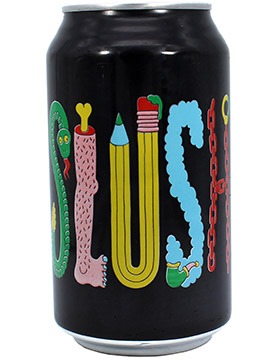Prairie Artisan Ales’ Slush clone
Prairie Artisan Ales’ Slush clone
5 gallons/19 L, all-grain)
OG = 1.046 FG = 1.010
IBU = 11 SRM = 3 ABV = 6.1%
A bright red, kettle-soured ale made with strawberry and raspberry fruit puree complemented with dried sweet orange peel and dried lemon peel.
Ingredients
7.8 lbs. (3.5 kg) Canadian Superior Pilsen malt
6 oz. (170 g) Weyermann acidulated malt
12 oz. (340 g) white wheat malt
1.5 lbs. (680 g) Briess Pilsen light dried malt extract (added post kettle sour)
9 oz. (255 g) sea salt
3 AAU Cascade hops (60 min.) (0.55 oz./16 g at 5.5% alpha acids)
2.5 lbs. (1.13 kg) Oregon Fruit strawberry puree
2.5 lbs. (1.13 kg) Oregon Fruit raspberry puree
Servomyces (yeast nutrient)
SafAle US-05, LalBrew BRY-97 (American West Coast Ale), Wyeast 1056 (American Ale), or White Labs WLP001 (California Ale) yeast
Lactobacillus strain of your preference
¾ cup corn sugar (if priming)
Step by step
Single-infusion mash with a ratio of 2 qts./lb. (4.2 L/kg) to provide a thin mash with high enzymatic activity. Target a mash temperature of 147 °F (64 °C) and mash for 60 minutes or until conversion is complete. Recirculate wort (vorlauf), then sparge with 5 gallons (19 L) of water at 170 °F (77 °C) and collect 6.5 gallons (24.6 L) of runoff to your boil kettle.
Reduce temperature to 110–114 °F (43–45 °C), add Lactobacillus, and try to maintain this temperature during the souring process. Ideally, pitch enough Lacto to get the pH to drop in 12 hours. Once pH has dropped to 3.5–3.0, proceed to boil for 60 minutes, adding sea salt, hops, and dried malt extract at the start of the boil. After the boil is complete, whirlpool for 10 minutes.
Chill the wort to 68 °F (20 °C) and transfer the wort to your fermenter. Pitch yeast, and set the fermenter in a cool, dark place to ferment at about 68 °F (20 °C).
After fermentation has mostly completed, add fruit to the fermenter. Once fermentation of the fruit has ended, crash cool, rack beer into a keg and force carbonate to 2.5 volumes, or prime and bottle condition.
Prairie Artisan Ales’ Slush clone
(5 gallons/19 L, extract only)
OG = 1.046 FG = 1.010
IBU = 11 SRM = 3 ABV = 6.1%
Ingredients
5.75 lbs. (2.6 kg) Briess Pilsen light DME
8 oz. (227 g) Briess Bavarian wheat DME
2 tsp. lactic acid, 88%
9 oz. (255 g) sea salt
3 AAU Cascade hops (60 min.) (0.55 oz./16 g at 5.5% alpha acids)
2.5 lbs. (1.13 kg) Oregon Fruit strawberry puree
2.5 lbs. (1.13 kg) Oregon Fruit raspberry puree
Servomyces (yeast nutrient)
SafAle US-05, LalBrew BRY-97 (American West Coast Ale), Wyeast 1056 (American Ale), or White Labs WLP001 (California Ale) yeast
Lactobacillus strain of your preference
¾ cup corn sugar (if priming)
Step by step
Before starting your brew, separately pre-boil and chill about 3.5 gallons (13.25 L) of water so you can add that to top up your fermenter later.
Heat about 2 gallons (7.6 L) of water to near boiling. The exact temperature doesn’t matter since there is no mashing. You want it hot enough to dissolve the DME but not too hot that it boils over. Take pot off the heat source and stir in 3⁄4 of the total volume of malt extract in any combination and the lactic acid. Raise to boil only briefly enough to sterilize your wort, then cool to 110–114 °F (43–45 °C), add Lactobacillus, and try to maintain this temperature during the souring process. Ideally, pitch enough Lacto to get the pH to drop in 12 hours. Once pH has dropped to 3.5–3.0, proceed to boil for 60 minutes, adding sea salt, hops, and remaining malt extract at the start of the boil. Knockout and whirlpool.
At flameout, chill wort to 68 °F (20 °C) and transfer the wort to your fermenter, topping up with pre-boiled and chilled water to a volume of 5.5 gallons (21 L). Pitch yeast and set the fermenter in a cool, dark place to ferment at about 68 °F (20 °C).
After fermentation has mostly completed, add fruit to the fermenter (or rack to secondary fermenter containing the fruit). The fruit will ferment somewhat. Once fermentation of the fruit has ended, crash cool, rack beer into a keg and force carbonate to 2.5 volumes, or prime and bottle condition.
Tips for success:
Because of the low pH, a higher-than-normal yeast pitch rate is advised. If target acidity is low, add malic, lactic, or phosphoric acid to adjust.
According to Head brewer Michael Lalli, “Don’t worry about a ‘CO2 blanket’ if the pH drop can happen in 12 hours.”
If you do not have the means or ability to go through the Lactobacillus souring process, you can simply use lactic acid to achieve the desired pH. However, it will provide a much less authentic version of the beer than souring using Lactobacillus at the proper temperatures.
Written by Dave Clark

A bright red, kettle-soured ale made with strawberry and raspberry fruit puree complemented with dried sweet orange peel and dried lemon peel.


